Low Profile Dual-Band Polarization Conversion Metasurface with Omnidirectional Polarization
Abstract
:1. Introduction
2. Design and Analysis
2.1. Design of PCM Element
2.2. Mechanism of PCM
3. Fabrication and Measurement
4. Conclusions
Author Contributions
Funding
Institutional Review Board Statement
Informed Consent Statement
Data Availability Statement
Conflicts of Interest
References
- Zhou, G.; Zhu, B.; Zhao, J.; Zhu, G.; Jin, B.; Feng, Y.; Kang, L.; Xu, W.; Chen, J.; Wu, P. A broadband reflective-type half-wave plate employing optical feedbacks. Sci. Rep. 2017, 7, 9103. [Google Scholar] [CrossRef] [Green Version]
- Zheng, Q.; Guo, C.; Vandenbosch, G.A.; Yuan, P.; Ding, J. Dual-broadband highly efficient reflective multi-polarisation converter based on multi-order plasmon resonant metasurface. IET Microw. Antennas Propag. 2020, 14, 967–972. [Google Scholar] [CrossRef]
- Benetou, M.I.; Tsakmakidis, K.L. Multifunctional plasmonic metasurface demultiplexer and wavelength-polarization controllable beam splitter. JOSA B 2021, 38, C50–C57. [Google Scholar] [CrossRef]
- Aparna, U.; Mruthyunjaya, H.S.; Sathish Kumar, M. Plasmonic nanoslit-based dual-wavelength multiplexer. J. Opt. 2020, 49, 17–22. [Google Scholar] [CrossRef]
- Kowerdziej, R.; Wróbel, J.; Kula, P. Ultrafast electrical switching of nanostructured metadevice with dual-frequency liquid crystal. Sci. Rep. 2019, 9, 20367. [Google Scholar] [CrossRef] [PubMed] [Green Version]
- Amireddy, K.K.; Balasubramaniam, K.; Rajagopal, P. Holey-structured metamaterial lens for subwavelength resolution in ultrasonic characterization of metallic components. Appl. Phys. Lett. 2016, 108, 224101. [Google Scholar] [CrossRef]
- Han, B.; Li, S.; Cao, X.; Han, J.; Jidi, L.; Li, Y. Dual-band transmissive metasurface with linear to dual-circular polarization conversion simultaneously. AIP Adv. 2020, 10, 125025. [Google Scholar] [CrossRef]
- Fahad, A.K.; Ruan, C.; Nazir, R.; Haq, T.U.; He, W. Dual-band ultrathin meta-array for polarization conversion in Ku/Ka-band with broadband transmission. IEEE Antennas Wirel. Propag. Lett. 2021, 19, 856–860. [Google Scholar] [CrossRef]
- Hoque, A.; Tariqul Islam, M.; Almutairi, A.F.; Alam, T.; Jit Singh, M.; Amin, N. A Polarization Independent Quasi-TEM Metamaterial Absorber for X and Ku Band Sensing Applications. Sensors 2018, 18, 4209. [Google Scholar] [CrossRef] [PubMed] [Green Version]
- Fu, Y.; Cheng, H.; Wu, J.; Li, Y.; Dai, Y.; Wen, D.; Yang, H. A multifunctional metasurface with asymmetric transmission and high-efficiency cross-polarization converter. J. Appl. Phys. 2022, 132, 223106. [Google Scholar] [CrossRef]
- Fei, P.; Guo, W.; Hu, W.; Zheng, Q.; Wen, X.; Chen, X.; Vandenbosch, G.A.E. A Transmissive Frequency-Reconfigurable Cross-Polarization Conversion Surface. IEEE Antennas Wirel. Propag. Lett. 2022, 21, 997–1001. [Google Scholar] [CrossRef]
- Ako, R.T.; Lee, W.S.; Atakaramians, S.; Bhaskaran, M.; Sriram, S.; Withayachumnankul, W. Ultra-wideband tri-layer transmissive linear polarization converter for terahertz waves. APL Photonics 2020, 5, 046101. [Google Scholar] [CrossRef] [Green Version]
- Hong, T.; Wang, S.; Liu, Z.; Gong, S. RCS Reduction and Gain Enhancement for the Circularly Polarized Array by Polarization Conversion Metasurface Coating. IEEE Antennas Wirel. Propag. Lett. 2019, 18, 167–171. [Google Scholar] [CrossRef]
- Ye, Y.; He, S. 90° polarization rotator using a bilayered chiral metamaterial with giant optical activity. Appl. Phys. Lett. 2010, 96, 203501. [Google Scholar] [CrossRef]
- Xu, P.; Jiang, W.X.; Wang, S.Y.; Cui, T.J. An Ultrathin Cross-Polarization Converter with Near Unity Efficiency for Transmitted Waves. IEEE Trans. Antennas Propag. 2018, 66, 4370–4373. [Google Scholar] [CrossRef]
- Zhao, Y.-T.; Zhang, J.-J.; Wu, B. Low Profile Reflective Polarization Conversion Metasurface With High Frequency Selectivity. IEEE Trans. Antennas Propag. 2022, 70, 10614–10622. [Google Scholar] [CrossRef]
- Xu, P.; Wang, S.-Y.; Geyi, W. A linear polarization converter with near unity efficiency in microwave regime. J. Appl. Phys. 2017, 121, 144502. [Google Scholar] [CrossRef]
- Zhou, X.; Wu, J.; Yang, H.; Li, S.; Yang, Y.; Chen, J. A dual-broadband dual-function polarization converter based on reflective metasurface. J. Appl. Phys. 2022, 132, 133103. [Google Scholar] [CrossRef]
- Zheng, Q.; Guo, C.; Ding, J.; Fei, P.; Vandenbosch, G.A.E. High-efficiency multi-band multi-polarization metasurface-based reflective converter with multiple plasmon resonances. J. Appl. Phys. 2021, 130, 193104. [Google Scholar] [CrossRef]
- Wu, J.; Syed, M.A.S.; Qi, L.; Tao, X.; Yang, J.; Wen, L. A double-layer high-transmission terahertz linear-to-circular polarization converter. J. Appl. Phys. 2022, 132, 013103. [Google Scholar] [CrossRef]
- Chen, W.; Yu, Y.; Mu, Q.; Campos, J.; Wang, Q.; Li, S.; Zhang, S.; Xuan, L. Super-broadband geometric phase devices based on circular polarization converter with mirror symmetry. Appl. Phys. Lett. 2021, 119, 101103. [Google Scholar] [CrossRef]
- Lin, B.; Huang, W.; Lv, L.; Guo, J.; Wang, Z.; Zhu, R. Second-Order Polarization Rotating Frequency-Selective Surface. IEEE Trans. Antennas Propag. 2021, 69, 7976–7981. [Google Scholar] [CrossRef]
- Baghel, A.K.; Kulkarni, S.S.; Nayak, S.K. Linear-to-cross-polarization transmission converter using ultrathin and smaller periodicity metasurface. IEEE Antennas Wirel. Propag. Lett. 2019, 18, 1433–1437. [Google Scholar] [CrossRef]
- Pozar, D.M. Microwave Engineering; John Wiley & Sons: Hoboken, NJ, USA, 2011. [Google Scholar]
- Zheng, Q.; Guo, C.; Ding, J. Wideband metasurface-based reflective polarization converter for linear-to-linear and linear-to-circular polarization conversion. IEEE Antennas Wirel. Propag. Lett. 2018, 17, 1459–1463. [Google Scholar] [CrossRef]
- Huang, X.; Yang, H.; Zhang, D.; Luo, Y. Ultrathin Dual-Band Metasurface Polarization Converter. IEEE Trans. Antennas Propag. 2019, 67, 4636–4641. [Google Scholar] [CrossRef]
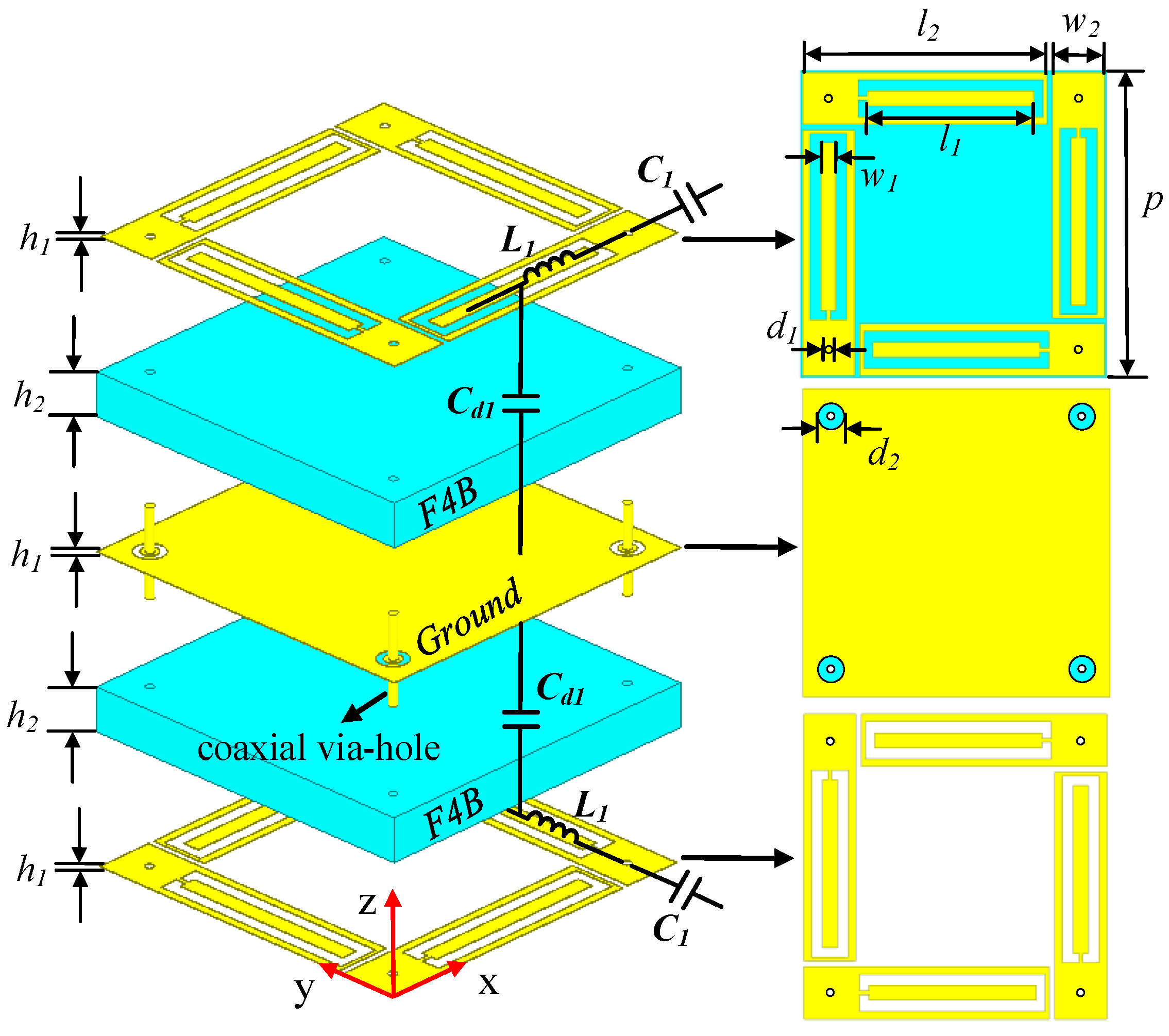



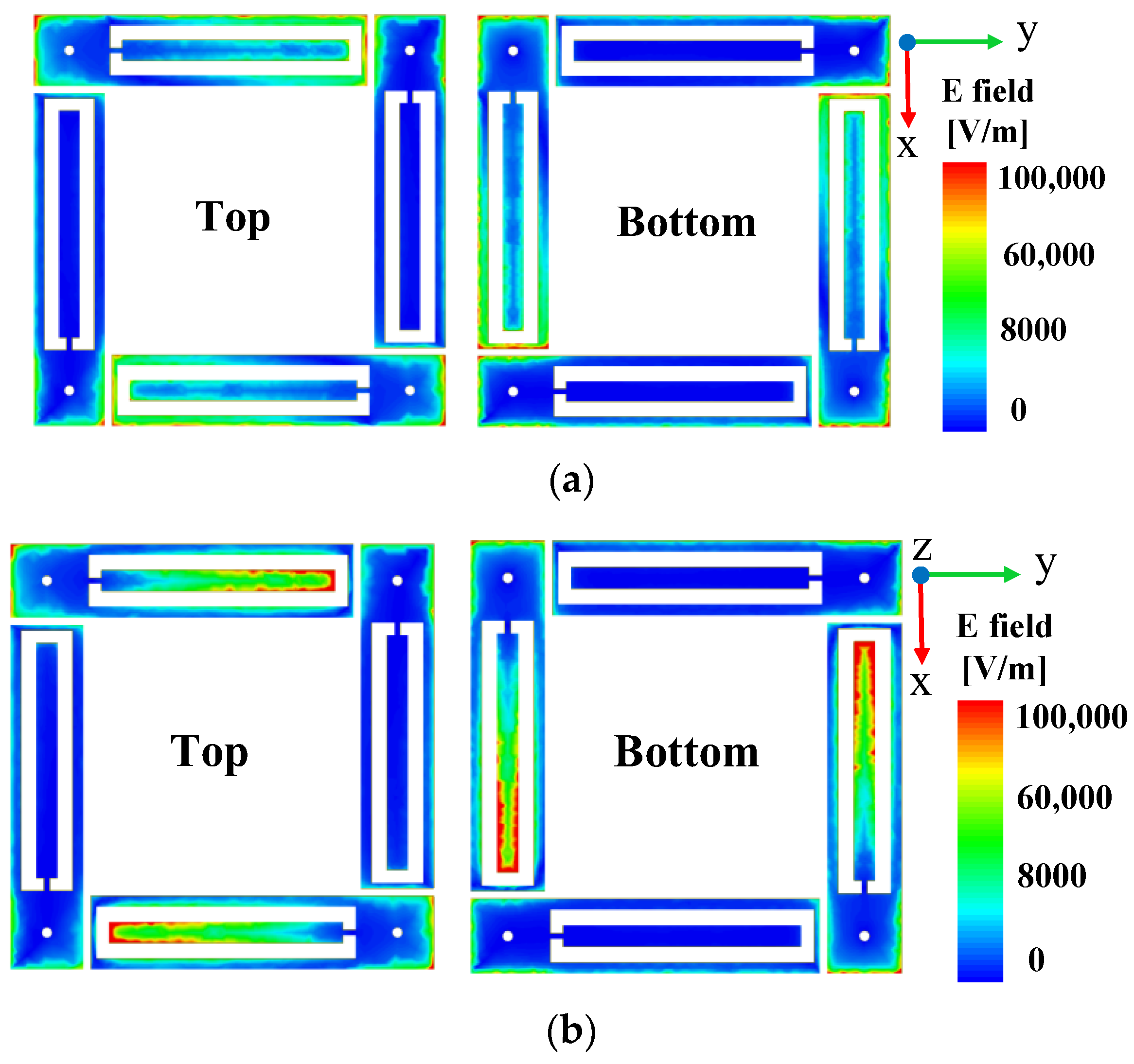
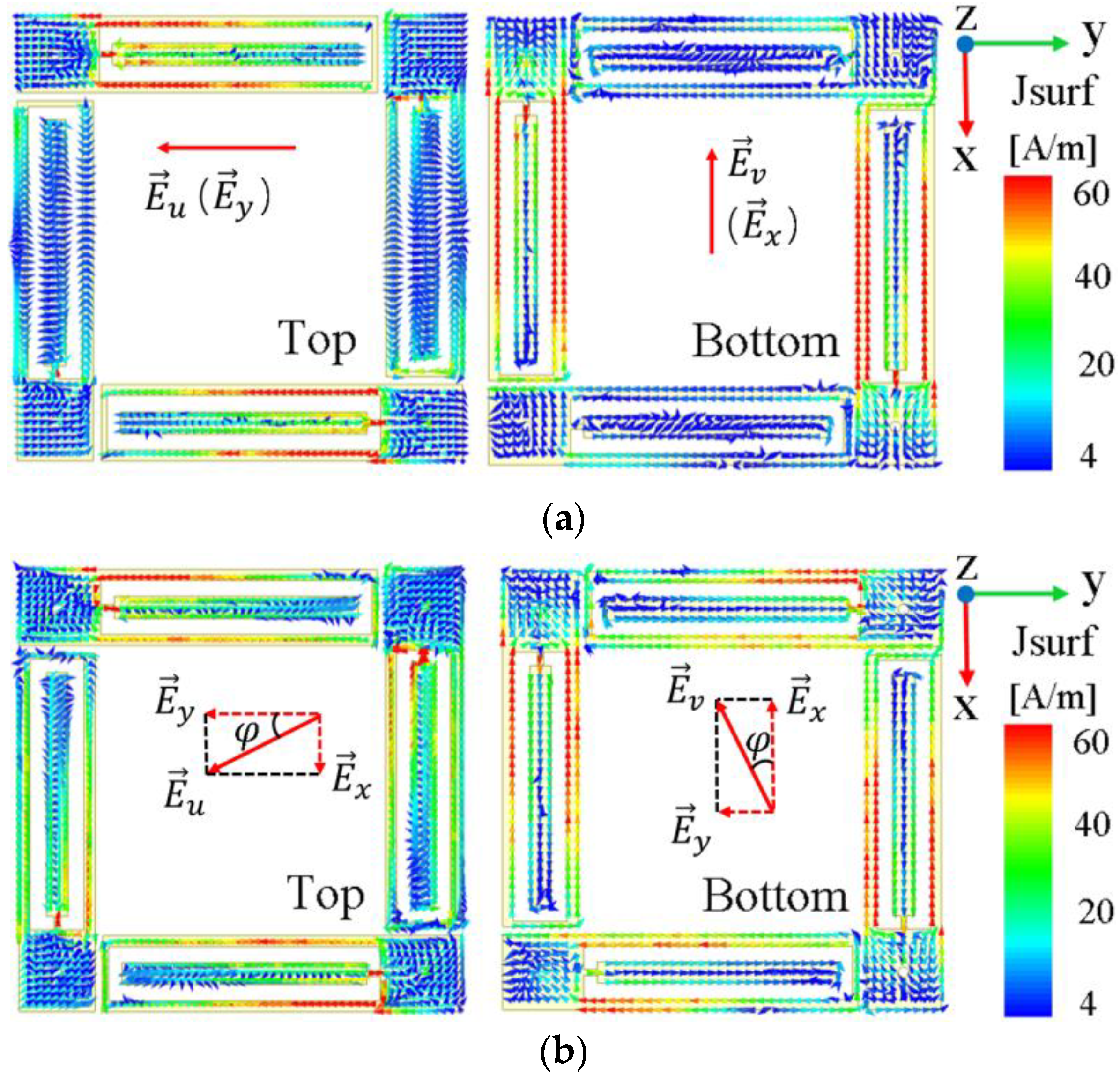

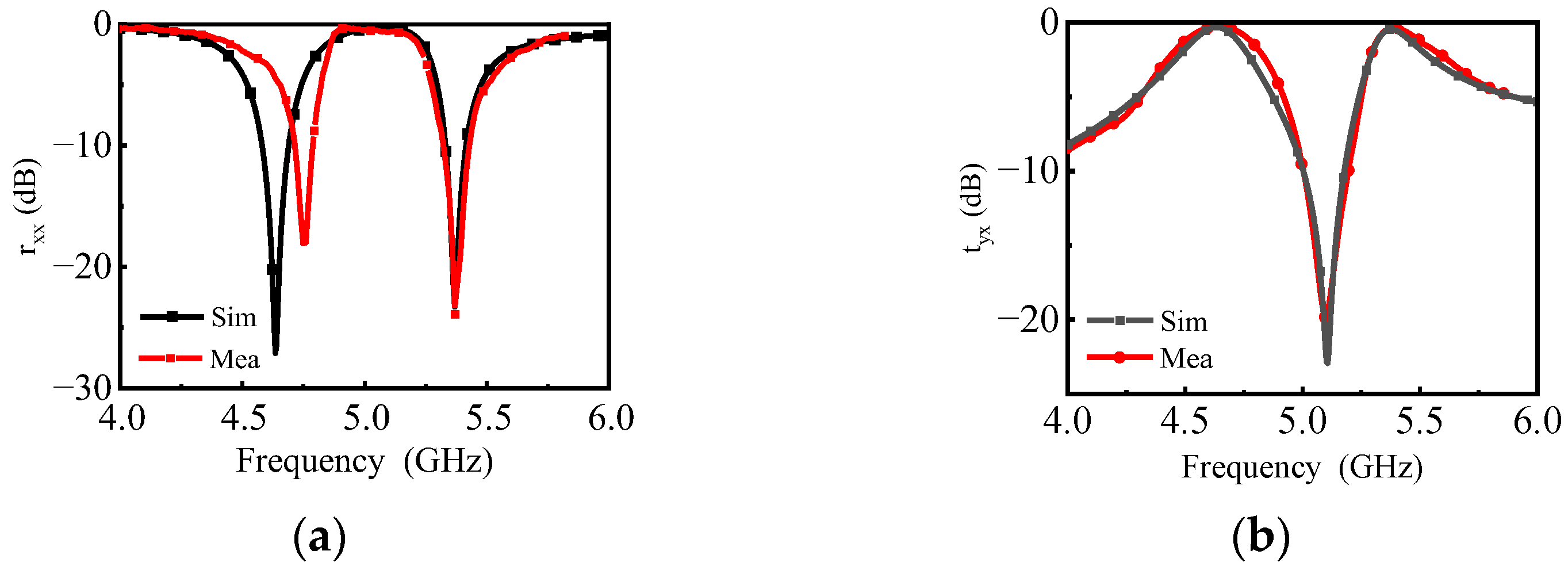
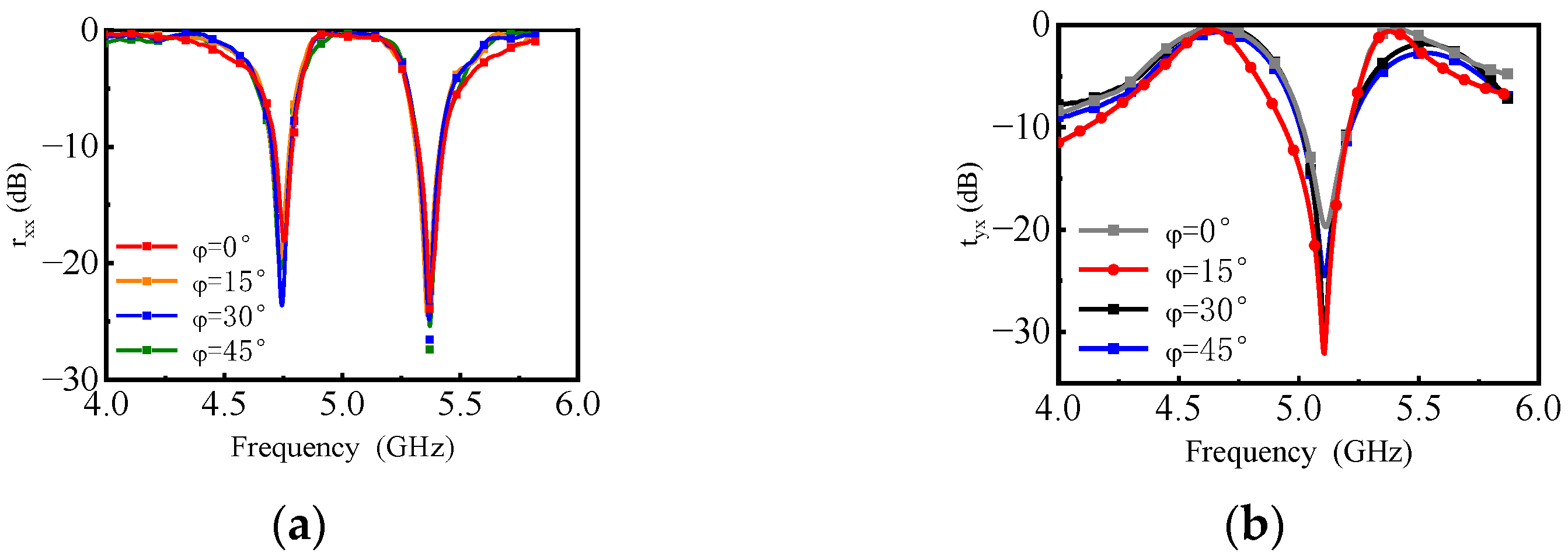
| Electric Cond. | Thermal Cond. |
|---|---|
| [S/m] | 401 [W/K/m] |
| Relative Permittivity | Loss Tangent |
|---|---|
| 2.65 | 0.002 |
| Ref. | Passband | PCR | Thickness (λL) | Insertion Loss (dB) | * OP |
|---|---|---|---|---|---|
| [14] | Dual | 90% | 0.13 | 0.37/0.2 | No (SP) |
| [15] | Single | 90% | 0.0235 | 1.16 | No (SP) |
| [22] | Single | 90% | 0.07 | 0.8 | No (DP) |
| [25] | Dual | 88% | 0.12 | 1.94/1.2 | No (DP) |
| [26] | Dual | 86% | 0.069 | 0.4/1.9 | No (DP) |
| This work | Dual | 90% | 0.062 | 0.22/0.35 | Yes |
Disclaimer/Publisher’s Note: The statements, opinions and data contained in all publications are solely those of the individual author(s) and contributor(s) and not of MDPI and/or the editor(s). MDPI and/or the editor(s) disclaim responsibility for any injury to people or property resulting from any ideas, methods, instructions or products referred to in the content. |
© 2023 by the authors. Licensee MDPI, Basel, Switzerland. This article is an open access article distributed under the terms and conditions of the Creative Commons Attribution (CC BY) license (https://creativecommons.org/licenses/by/4.0/).
Share and Cite
Zhang, J.-J.; Xu, W.-X.; Zhao, Y.-T.; Xie, H.-Y.; Zu, H.-R.; Wu, B. Low Profile Dual-Band Polarization Conversion Metasurface with Omnidirectional Polarization. Materials 2023, 16, 4347. https://doi.org/10.3390/ma16124347
Zhang J-J, Xu W-X, Zhao Y-T, Xie H-Y, Zu H-R, Wu B. Low Profile Dual-Band Polarization Conversion Metasurface with Omnidirectional Polarization. Materials. 2023; 16(12):4347. https://doi.org/10.3390/ma16124347
Chicago/Turabian StyleZhang, Jun-Jie, Wei-Xi Xu, Yu-Tong Zhao, Han-Yu Xie, Hao-Ran Zu, and Bian Wu. 2023. "Low Profile Dual-Band Polarization Conversion Metasurface with Omnidirectional Polarization" Materials 16, no. 12: 4347. https://doi.org/10.3390/ma16124347





